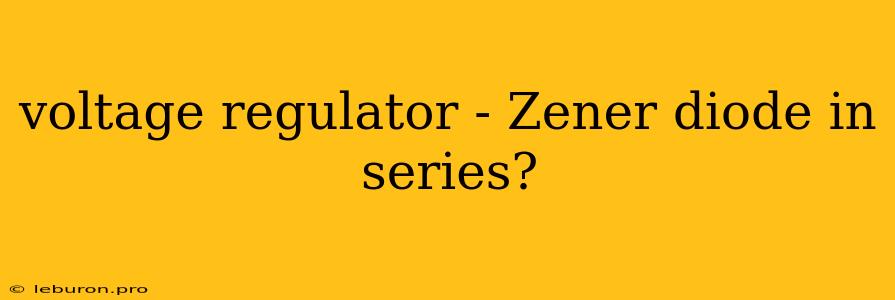Voltage regulation is a crucial aspect of electronic circuits, ensuring that sensitive components receive a stable and consistent power supply. One common method for achieving voltage regulation involves using a Zener diode in series. This technique offers a straightforward and cost-effective solution for maintaining a stable output voltage, even when the input voltage fluctuates. This article delves into the operation of a voltage regulator using a Zener diode in series, exploring its advantages, limitations, and practical applications.
Understanding Zener Diodes and Voltage Regulation
A Zener diode is a special type of diode designed to operate in the reverse breakdown region. Unlike a regular diode, which blocks current flow in the reverse direction, a Zener diode allows a controlled current flow when the reverse voltage across it exceeds a specific threshold known as the Zener voltage (Vz). This breakdown characteristic makes Zener diodes ideal for voltage regulation purposes.
How a Zener Diode Works in a Series Regulator
In a series voltage regulator, the Zener diode is connected in series with the load, as shown in the following circuit diagram:
!
- Input Voltage (Vin): The input voltage is the unregulated voltage supplied to the circuit.
- Zener Diode (Vz): The Zener diode has a specific Zener voltage rating (Vz), which determines the output voltage.
- Resistor (R): The resistor limits the current flowing through the Zener diode and the load.
- Load (RL): The load represents the component or circuit that requires a regulated voltage.
How the Circuit Operates:
- When the input voltage (Vin) is greater than the Zener voltage (Vz), the Zener diode enters its reverse breakdown region.
- The Zener diode conducts current, maintaining a constant voltage drop across it equal to Vz.
- The voltage across the load (Vout) is equal to the Zener voltage (Vz) minus the voltage drop across the resistor (VR).
- The resistor (R) limits the current flowing through the Zener diode and the load.
Advantages of Using a Zener Diode in Series:
- Simple and Inexpensive: The circuit is simple to design and implement, requiring only a few components.
- Good Regulation for Small Load Variations: The Zener diode maintains a relatively stable output voltage for small changes in the input voltage or load current.
- Compact Size: Zener diode voltage regulators can be compact and easily integrated into various electronic designs.
Limitations of the Zener Diode Series Regulator:
- Limited Output Current: Zener diodes have a maximum current rating, which limits the amount of current that the circuit can supply to the load.
- Power Dissipation: The Zener diode dissipates power in the form of heat, which can be significant if the input voltage is high or the load current is large.
- Inefficient for Large Load Variations: The regulation performance deteriorates for significant changes in the input voltage or load current.
Applications of Zener Diode Series Regulators
Despite its limitations, the Zener diode series regulator finds applications in a wide range of electronic circuits, including:
- Low-Power Applications: They are suitable for powering small electronic devices, sensors, and microcontrollers.
- Voltage References: Zener diodes can serve as stable voltage references for other circuits.
- Overvoltage Protection: The Zener diode can protect sensitive components from excessive input voltages by shunting excess current to ground.
- Clipping Circuits: Zener diodes are used in clipping circuits to remove the positive or negative peaks of a signal.
Selecting a Zener Diode for Series Regulation:
Choosing the right Zener diode for a series regulator depends on the desired output voltage and the maximum load current.
- Zener Voltage (Vz): Select a Zener diode with a Vz rating equal to the desired output voltage.
- Power Dissipation: Ensure the Zener diode's power dissipation rating is sufficient for the expected current and voltage drop.
- Maximum Current Rating: The diode's maximum current rating should be greater than the maximum load current.
Designing a Series Zener Diode Regulator:
- Determine the Output Voltage (Vout): This is the desired regulated voltage.
- Select a Zener Diode (Vz): Choose a Zener diode with a Vz value equal to Vout.
- Calculate the Resistor Value (R):
- R = (Vin - Vz) / Iload
- Vin: Input voltage
- Vz: Zener voltage
- Iload: Load current
Note: The resistor value should be chosen to limit the current through the Zener diode to a safe level, taking into account the diode's maximum current rating.
Conclusion
The Zener diode in series provides a simple and effective method for voltage regulation in various applications. Its advantages include simplicity, cost-effectiveness, and good regulation for small load variations. However, limitations such as limited output current and power dissipation must be considered during design and implementation. By carefully selecting a Zener diode and designing the circuit appropriately, the voltage regulator can provide a stable and consistent output voltage for sensitive electronic components.
